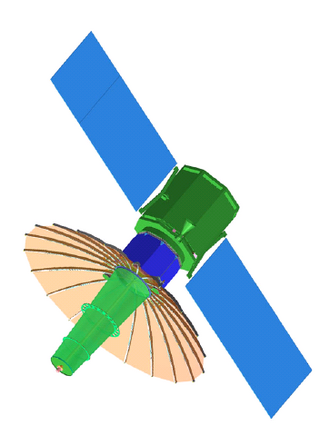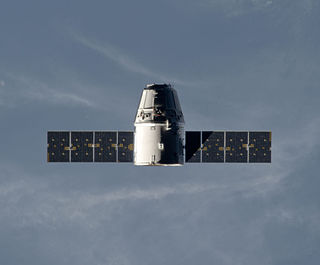Orbital Sciences Corporation was an American company specializing in the design, manufacture, and launch of small- and medium- class space and launch vehicle systems for commercial, military and other government customers. In 2014, Orbital merged with Alliant Techsystems to create a new company called Orbital ATK, Inc., which in turn was purchased by Northrop Grumman in 2018. The remnants of the former Orbital Sciences Corporation today are a subsidiary of Northrop Grumman, known as Northrop Grumman Innovation Systems.

Falcon 1 was a small-lift launch vehicle that was operated from 2006 to 2009 by SpaceX, an American aerospace manufacturer. On 28 September 2008, Falcon 1 became the first privately-developed fully liquid-fueled launch vehicle to go into orbit around the Earth.

The Boeing X-37, also known as the Orbital Test Vehicle (OTV), is a reusable robotic spacecraft. It is boosted into space by a launch vehicle, then re-enters Earth's atmosphere and lands as a spaceplane. The X-37 is operated by the United States Space Force for orbital spaceflight missions intended to demonstrate reusable space technologies. It is a 120-percent-scaled derivative of the earlier Boeing X-40. The X-37 began as a NASA project in 1999, before being transferred to the United States Department of Defense in 2004. Until 2019, the program was managed by Air Force Space Command.

SpaceQuest, Ltd. is a spacecraft components and engineering company located in Fairfax, Virginia, which focuses on the operations of small satellites.

TacSat-2 is the first in a series of U.S. military experimental technology and communication satellites.TacSat-2 (also known as JWS-D1 was an experimental satellite built by the USAF's Air Force Research Laboratory with an operational life expected to be not more than one year as part of the "Advanced Concept Technology Demonstration" program.
The Space Test Program (STP) is the primary provider of spaceflight for the United States Department of Defense (DoD) space science and technology community. STP is managed by a group within the Advanced Systems and Development Directorate, a directorate of the Space and Missile Systems Center of the United States Space Force. STP provides spaceflight via the International Space Station (ISS), piggybacks, secondary payloads and dedicated launch services.

TacSat-3 is the second in a series of U.S. military experimental technology and communication satellites. It was assembled in an Air Force Research Laboratory (AFRL) Space Vehicles Directorate facility at Kirtland Air Force Base, New Mexico. The TacSat satellites are all designed to demonstrate the ability to provide real-time data collected from space to combatant commanders in the field.
The Operationally Responsive Space Office is a joint initiative of several agencies within the United States Department of Defense (DoD). The "stand up" of the office took place 21 May 2007 at Kirtland Air Force Base. The first director of the ORS Office was Col. Kevin McLaughlin, who was also dual-hatted as commander of the Space Development and Test Wing located at Kirtland. The ORS Office focuses on providing quick-response tactical space-based capabilities to the warfighter utilizing smaller satellites, such as the Tactical Satellite Program and smaller launch vehicles.

TacSat-4 is the third in a series of U.S. military experimental technology and communication satellites. The United States Naval Research Laboratory (NRL) is the program manager. The Office of Naval Research (ONR) sponsored the development of the payload and funded the first year of operations. The Office of the Director of Defense Research and Engineering (DDR&E) funded the standardized spacecraft bus and the Operationally Responsive Space Office (ORS) funded the launch that will be performed by the Air Force's Space and Missile Systems Center (SMC).
Orbcomm is a family of low Earth orbit communications satellites, operated by the United States satellite communications company Orbcomm. As of July 2014, 51 such satellites have orbited Earth, with 50 still continuing to do so.

During the second half of 2002, the Naval Research Laboratory studied the tactical application of space assets. Relatively new technologies and processes in the areas of microsatellites, affordable and quick-response launch vehicles, and the classified SIPRNet made tactical use of space assets possible in the relatively near term. The DoD's Office of Force Transformation (OFT) agreed with the core findings of the study and decided to start an Operationally Responsive Space (ORS) Initiative consisting of a series of experiments. TacSat-1 is the first experiment in this OFT initiative. The TacSat-1 experiment received go-ahead on 7 May 2003.
CP6, also known as CP6 CubeSat, CalPoly CP-6, PolySat-6 or PolySat CP6 is a single-unit CubeSat which was built and operated by the California Polytechnic State University (CalPoly). It was primarily intended to perform a technology demonstration mission. The main experiment consisted of sensors to determine the spacecraft's attitude. Cameras on the satellite will be used to verify the data returned by the attitude sensors.

SpaceX COTS Demo Flight 1 was the first orbital spaceflight of the Dragon cargo spacecraft, and the second overall flight of the Falcon 9 rocket manufactured by SpaceX. It was also the first demonstration flight for NASA's Commercial Orbital Transportation Services (COTS) program. The primary mission objectives were to test the orbital maneuvering and reentry of the Dragon capsule. The mission also aimed to test fixes to the Falcon 9 rocket, particularly the unplanned roll of the first stage that occurred during flight 1. Liftoff occurred on 8 December 2010 at 15:43 UTC.

SpaceX CRS-1, also known as SpX-1, was SpaceX's first operational cargo mission to the International Space Station, under their Commercial Resupply Services (CRS-1) contract with NASA. It was the third flight for the uncrewed Dragon cargo spacecraft, and the fourth overall flight for the company's two-stage Falcon 9 launch vehicle. The launch occurred on 8 October 2012 at 00:34:07 UTC.
The EELV Secondary Payload Adapter (ESPA) is an adapter for launching secondary payloads on orbital launch vehicles.
Technology Education Satellite (TechEdSat) is a successful nano-sat flight series conducted from the NASA Ames Research Center in collaboration with numerous universities. While one of the principal aims has been to introduce young professionals and university students to the practical realm of developing space flight hardware, considerable innovations have been introduced. In addition, this evolving flight platform has tested concepts for Low Earth Orbit (LEO) sample return, as well as planetary nano-sat class mission concepts.

Busek Co. Inc. is an American spacecraft propulsion company that provides thrusters, electronics, and complete systems for spacecraft.

SpaceX CRS-4, also known as SpX-4, was a Commercial Resupply Service mission to the International Space Station (ISS), contracted to NASA, which was launched on 21 September 2014 and arrived at the space station on 23 September 2014. It was the sixth flight for SpaceX's uncrewed Dragon cargo spacecraft, and the fourth SpaceX operational mission contracted to NASA under a Commercial Resupply Services contract. The mission brought equipment and supplies to the space station, including the first 3D printer to be tested in space, a device to measure wind speed on Earth, and small satellites to be launched from the station. It also brought 20 mice for long-term research aboard the ISS.

The Green Propellant Infusion Mission (GPIM) was a NASA technology demonstrator project that tested a less toxic and higher performance/efficiency chemical propellant for next-generation launch vehicles and CubeSat spacecraft. When compared to the present high-thrust and high-performance industry standard for orbital maneuvering systems, which for decades, have exclusively been reliant upon toxic hydrazine based propellant formulations, the "greener" hydroxylammonium nitrate (HAN) monopropellant offers many advantages for future satellites, including longer mission durations, additional maneuverability, increased payload space and simplified launch processing. The GPIM was managed by NASA's Marshall Space Flight Center in Huntsville, Alabama, and was part of NASA's Technology Demonstration Mission Program within the Space Technology Mission Directorate.












